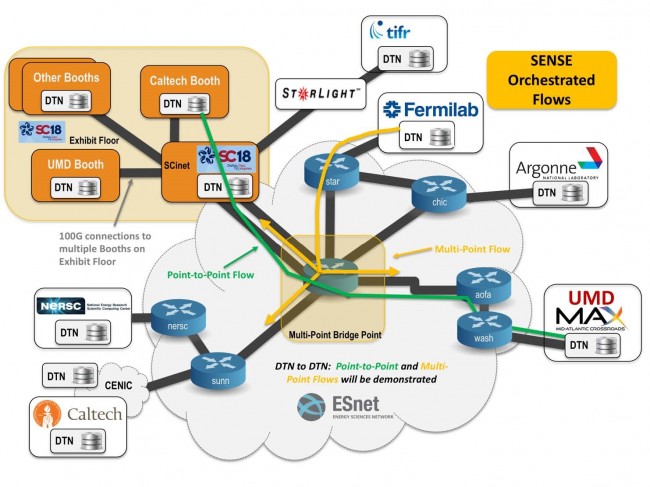Software-defined network for End-to-end Networked Science at Exascale (SENSE)
SENSE is building smart network services to accelerate scientific discovery in the era of ‘big data’ driven by exascale computing, cloud computing, machine learning, and AI. The SENSE SC18 demonstration in the Caltech and University of Maryland booths showcases a comprehensive approach to request and provision end-to-end network services across domains that combines deployment of infrastructure across multiple labs/campuses, SC booths and WAN with a focus on usability, performance, and resilience.
A SENSE testbed consisting of network and end-system resources have been deployed across DOE laboratories, including Fermilab and Argonne National Lab and the National Energy Research Scientific Computing Center at Berkeley Lab; facilities at Caltech and the University of Maryland; MAX (the Mid-Atlantic Crossroads) and ESnet. To control network resources, the SENSE system interacts with the production provisioning system of ESnet and other regional and site networks. To control end-systems, SENSE software is deployed at the end-sites.
The SENSE demonstration at SC18 uses this persistent testbed and adds resources on the exhibit showroom floor at the conference. As shown in the figure below, the SC18 resources include data transfer nodes (DTNs) deployed in the Caltech and University of Maryland booths. Connections to the SC18 SCinet infrastructure provide multiple 100 Gbps connections back to the SENSE testbed. This infrastructure will be utilized to demonstrate the end-to-end SENSE services and includes high-speed data transfers and provisioning services.

SDN-Assisted NDN for Data-Intensive Experiments (SANDIE)
We are developing a new system for data access and analysis, SDN Assisted NDN for Data-Intensive Experiments (SANDIE), based on a novel yet wellfounded Named Data Networking (NDN) architecture, supported by advanced Software Defined Network (SDN) services to meet the challenges facing data-intensive science.
SANDIE builds on the use of NDN protocols and services, including hierarchical naming conventions and advanced forwarding, caching, and congestion control algorithms developed at Northeastern, designed to achieve highly efficient data access, distribution and curation.
SANDIE is integrated with the SDN methods and subsystems already developed and under continued development by the Caltech, Northeastern and Colorado high energy physics, network, and computer science teams, as well as their HEP, climate, computer and network science and engineering partners, which are targeted at efficient, reliable, and predictable high throughput delivery of large data transactions across complex networks.
SANDIE will leverage and integrate these products and developments as the basis of the next-generation data distribution and delivery systems serving the major data-intensive science programs. While our initial focus will be CMS and the other LHC experiments, we will also apply SANDIE’s methods and tools in test deployments serving astrophysical sky survey programs such as LSST, paving the way towards the SKA and the other programs mentioned above in the future.
The operation of the system being developed will adapt to three levels of data intensiveness, scoped according to the size of the data transactions involved and the time to complete them:
(1) Up to ~100 Gbyte scale: Transactions at this level can be accommodated using the usual NDN routing and caching methods, with data transport speeds of order 1 gigabit/sec (Gbps).
(2) 0.1 – 10 Terabyte: High throughput methods will be applied to reach 10 Gbps or more
(3) 10 Terabytes and Up: State of the art methods both for high throughput and for allocating guaranteed bandwidth will be applied to have the transaction completed in a finite time.
Past R&D projects
- US LHCNet – provides transatlantic connections of the Tier1 computing facilities at Fermilab and Brookhaven with the Tier0 and Tier1 facilities at CERN as well as Tier1s elsewhere in Europe and Asia. Together with ESnet, Internet2, the GEANT pan-European network, and NSF’s UltraLight project, US LHCNet also supports connections between the Tier2 centers and the Tier1s as needed. Since 2014, this is managed by ESnet.
- ANSE – ANSE (Advanced Network Services for Experiments) in the context of CMS, aims to greatly improve PhEDEx’ network awareness as well as to provide bandwidth provisioning capabilities based on bulk data transfer requirements.
- MonALISA – Monitoring Agents using a Large Integrated Services Architecture.
- Fast Data Transfer (FDT) – Application for Efficient Data Transfers